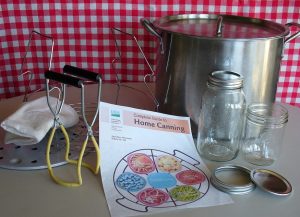
The canning preservation method involves just a few essential concepts. Once you learn the basics, canning is a great way to turn fresh food into shelf-stable products that are safe for storage at room temperature. The fundamentals of canning have not changed since Frenchman Nicolas Appert invented the process over 200 years ago.
People have the most trouble with canning when they don’t understand why a step is necessary. If you are new to canning, read What do you know about botulism? How safe is home canning? Here are six essential concepts you need to know and practice to get started in canning food safely:
- Use threaded glass canning jars. Don’t be tempted to re-use jars from commercially prepared products such as peanut butter or mayonnaise for canning because they are not formulated for multiple uses, can easily crack during processing, and may not be designed to accept the two-piece canning lid. Likewise, old jar designs with zinc lids or wire bails have increased seal failure rates when used for canning–but can be used for dry storage. Whether you buy new canning jars or scour garage sales for used jars, make sure they are made for canning (carry the “mason” name), have a threaded top that accepts the two-piece closures, and contain no nicks or cracks.
- Purchase new flat metal lids for each use. You can reuse screw bands year after year, provided they are not bent or rusted and still screw easily onto the canning jar. Since you may remove the screw bands after jars have cooled, most people need only 1 or 2 dozen screw bands. However, to ensure a safe, tight jar seal, you must use buy (regular or wide) flat canning jar lids every time.
- Can only foods that are high in acid. Because C. botulinum does not become active in high-acid environments, canning only high acid foods eliminates the concern about botulism poisoning. High acid foods include most fruits, fruit products, and acidified vegetables such as tomatoes, quick-process pickles, and relishes.
- Prepare the food according to a tested recipe. Find free, tested canning recipes online from extension agencies across the country on the National Center for Home Food Preservation website and in the free downloadable booklet the USDA Complete Guide to Home Canning. Canning recipe books written after 2009 that are based on the latest research and guidelines are also good sources for tested recipes, including The Home Preserving Bible by Carole Cancler. Never old or untested recipes that may increase the rate of seal failure or create unsafe canned foods.
- Process canned foods correctly. A tested recipe gives you the necessary details for processing the food correctly. These details include the type of pack (raw vs. hot), jar size, headspace, and processing time. You must follow the procedures according to each recipe; they are not interchangeable from one recipe to another, even if the products seem similar. Only use the packing methods, jar sizes, headspace, and processing times specified in a tested recipe.
- Follow all procedures accurately. The few recent food botulism cases in home canned foods were caused by improperly home canned low acid foods such as vegetables and fish. Never take shortcuts that may increase the rate of seal failure or create unsafe canned foods.
For information about seven other food preservation methods, including over 300 delicious recipes, get the book The Home Preserving Bible by Carole Cancler, available from booksellers everywhere.




